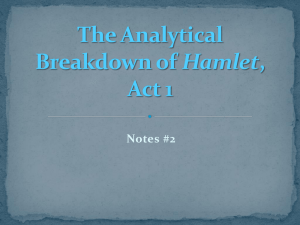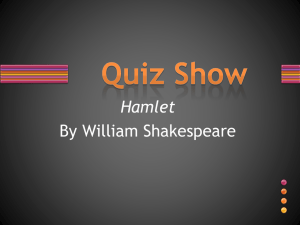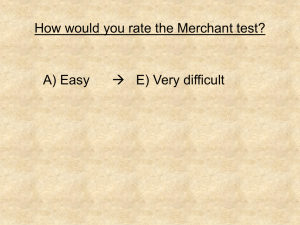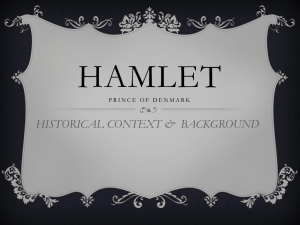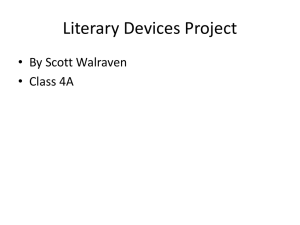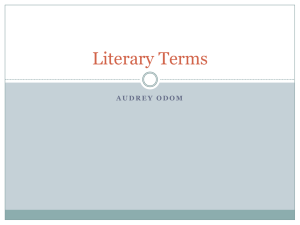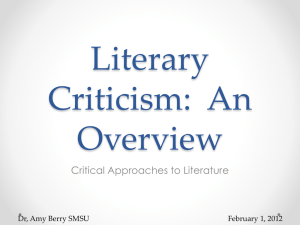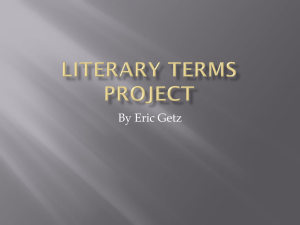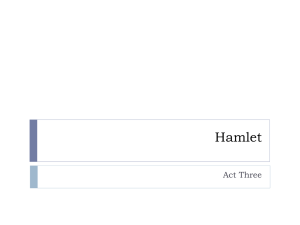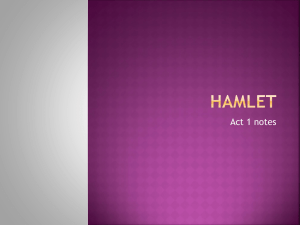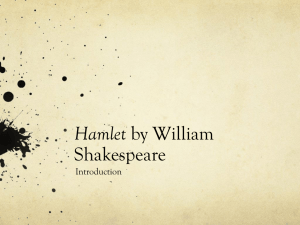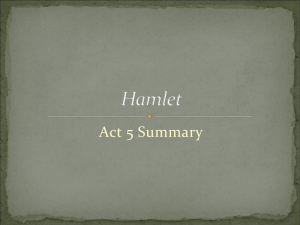Example in Hamlet
advertisement
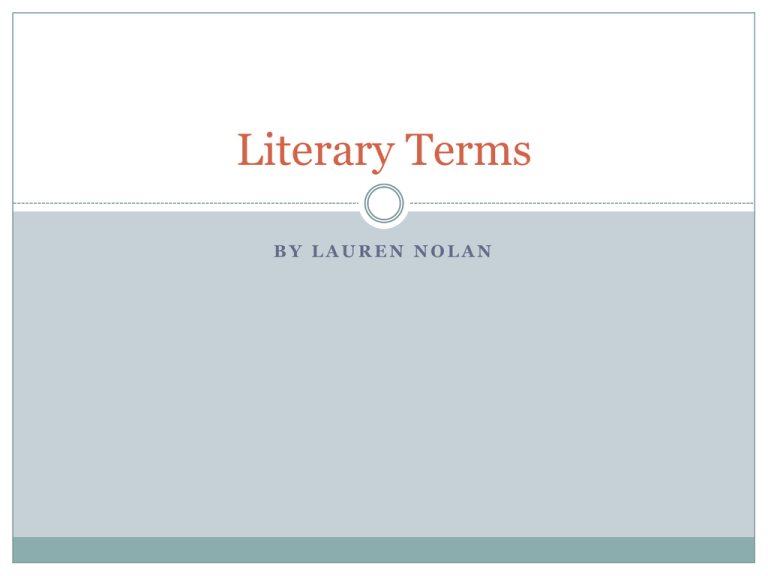
Literary Terms BY LAUREN NOLAN Imagery Imagery is an author’s use of vivid and descriptive language to add depth to their work. Example: A host, of golden daffodils; Beside the lake, beneath the trees, fluttering and dancing in the breeze. continuous as the stars that shine and twinkle on the Milky Way- “Daffodils” William Wordsworth Example in Hamlet O, that this too too solid flesh would melt, thaw, and resolve itself into a dew. Act I scene ii Simile A simile is a comparison of two things using words such as “like” or “as”. Example: “She floats down the aisle like a pageant queen” “Speak Now”- Taylor Swift Example in Hamlet: "Make thy two eyes, like stars, start from their spheres” Act II scene ii Metaphor A metaphor is a figure of speech in which a term or phrase is applied to something to which it is not literally applicable in order to suggest a resemblance. Example: “Love is a Temple” “One” by U2 Example in Hamlet: "This is th' impostume of much wealth and peace, that inward breaks and shows no cause without why the man dies.” Act IV scene iv Personification Personification is the attribution of human nature or character to inanimate objects. Example: “Pocketful of sunshine” Natasha Bedingfield- “Pocketful of Sunshine” Example in Hamlet: So full of artless jealousy is guilt, it spills itself in fearing to be spilt. Act IV scene iii Apostrophe Apostrophe is the addressing of a usually absent person or a usually personified thing rhetorically. Example: Tom Hanks referring to the volleyball, an inanimate object, in the movie Castaway. Example in Hamlet: “Let me not think on’t; frailty, thy name is women” Act I scene ii Symbol A symbol is an action, object, or event that expresses or represents a particular idea or quality. Example: The green light in The Great Gatsby symbolizes new life. Example in Hamlet: Yorick’s skull in Act V scene i. The skull is a symbol of death, an important motif throughout the play. Allegory Allegory is a story in which the characters and events are symbols that stand for ideas about human life or for a political or historical situation. Example: The Truman Show is an example of allegory. Truman makes the decision to get out of the town and not be tied to their private system of merchant law. Example in Hamlet: The ghost in Act I represents Hamlet’s father and forces Hamlet to think about death more in depth. Paradox A paradox is a statement that apparently contradicts itself and yet might be true. Example: “Everyone can be super. And when everyone’s super…no one will be” The Incredibles Example in Hamlet: “You are the queen, your husband’s brother’s wife.” Act III scene iv Hyperbole Hyperbole is the use of exaggeration as a rhetorical device or figure of speech. Example: "It seems to me you lived your life like a candle in the wind” "Candle In the Wind" Elton John Example in Hamlet: “O that this too too solid flesh would melt, thaw and resolve into a dew.” Act I scene ii Understatement An understatement is the presentation of something as being smaller, worse, or less important than it actually is. Example: “Cannibalism is frowned upon in most societies.” 'Charlie and the Chocolate Factory’ Example in Hamlet: “With such dexterity to incestuous sheets! It is not nor it cannot come to good” Act I scene ii Irony Irony is a situation that is strange or funny because things happen in a way that seems to be the opposite of what you expected. Example: “It's like rain on your weddin' day It's a free ride when you've already paid. It's the good advice that you just didn't take, And who would've thought, it figures” ‘Ironic’ Alanis Morissette Example in Hamlet: “I am too much in the sun.” Act I scene ii Chiasmus Chiasmus is the figure of speech in which two or more clauses are related to each other through a reversal of structures in order to make a lager point. Example: “Don't sweat the petty things, and don't pet the sweaty things.” - Jacquelyn Small. Example in Hamlet: “Whether love lead to fortune, or else fortune love.” Act IV scene iii “To be or not to be” Act III scene i Metonymy Metonymy is a figure of speech in which a thing or concept is called not by its own name but rather by the name of something associated in meaning with that thing or concept. Example: Referring to royalty as the “crown” is an example of metonymy. Example in Hamlet: “I saw him enter such a house of sale.” Act II scene ii Synecdoche Synecdoche is a figure of speech in which a term for a part of something to the whole of something or vice-versa. Example: “Our song is a slamming screen door, sneaking out late.” ‘Our Song’ Taylor Swift Example in Hamlet: "So the whole ear of Denmark Is by a forged process of my death Rankly abused." (ear stands for Denmark), Act I, scene v, Repartee Repartee is a conversation or speech characterized by quick, witty comments or replies. Example in Hamlet: “One.” “No.” “Judgment.” “A hit, a very palpable hit.” “Well again.” Stichomythia Stichomythia is a dialogue in which two characters speak alternate lines of verse, used as a stylistic device in ancient Greek drama. Example in Hamlet: “Come, come, you answer with an idle tongue.” “Go, go, you question with a wicked tongue.” Act III scene iv Stock Characters A stock character is someone based on common literary or social stereotypes. Example: An example of a stock character is the school diva, this is Blair Waldorf in Gossip Girl. Example in Hamlet: Polonius is a stock character. He represents the older man with former wisdom, and unknowingly through his failures provides comic relief. Alliteration Alliteration is repetition of a particular sound in the stressed syllables of a series of words or phrases. Example: Sally sells seashells by the seashore. Example in Hamlet: "With witchcraft of his wit, with traitorous gifts” Act I scene v Assonance Assonance is the repetition of vowel sounds to create internal rhyming within phrases or sentences Example: "I feel the need, the need for speed.” Top Gun Example in Hamlet: “For in that sleep of death, what dreams may come” Act I scene i Consonance Consonance is the repetition of the same consonant two or more times in short succession. Example: Peter Piper picked a peck of pickled peppers Example in Hamlet: “Thou wretched, rash, intruding fool, farewell.” Act III scene iv Rhyme Rhyme is correspondence of sound between words or the endings of words, especially when these are used at the ends of lines of poetry. Example: “Humpty Dumpty sat on a wall Humpty Dumpty had a great fall” Example in Hamlet: “The play's the thing Wherein I'll catch the conscious of the King.” Act II scene ii Rhythm Rhythm is a strong, regular, repeated pattern of movement or sound. Example: In songs, the rhythm is the beat. Example in Hamlet: Hamlet is written in iambic pentameter, which gives it rhythm Meter Meter is an arranged and measured rhythm in verse: rhythm that continuously repeats a single basic pattern. Example in Hamlet: O that this too too solid flesh would melt, Thaw, and resolve itself into a dew! Or that the Everlasting had not fix’d His canon ’gainst self-slaughter! O God! O God!” Act II scene ii End-Stopped Line End-stopped line is a feature in poetry in which the syntactic unit corresponds in length to the line. Example: “Shall I compare thee to a summer's day? Thou art more lovely and more temperate. Rough winds do shake the darling buds of May, And summer's lease hath all too short a date.” Sonnet 18 Example in Hamlet: “Without the which we are pictures, or mere beasts” Act IV scene v Run-On Line Run-on line is when there is no punctuation at the end of the line. Example in Hamlet: “Will nothing stick our person to arraign” Act IV scene v Caesura Caesura is a complete pause in a line of poetry or in musical composition. Example: To err is human; || to forgive, divine ~ Alexander Pope Example in Hamlet: 'To Be, or Not To Be..." Act III scene i Free Verse Free verse is an open form of poetry, it does not use consistent meter patterns or rhyme or any other musical pattern. Example: Some kind of attraction that is neither Animal, vegetable, nor mineral, a power not Solar, fusion, or magnetic And it is all in my head that I could see into his And find myself sitting there. ‘Feelings Now’ Katherine Foreman Example in Hamlet: "Indeed this counselor / Is now most still, most secret, and most grave, / Who was in life a foolish prating knave” Act III, Scene 4 Iambic Pentameter Iambic Pentameter is the particular rhythm that the words establish in that line. Example: “But, soft! what light through yonder window breaks? It is the east, and Juliet is the sun” Romeo and Juliet. Example in Hamlet: “How noble in reason! how infinite in faculty! in form, in moving, how express and admirable! in action how like an angel! in apprehension how like a god! the beauty of the world! the paragon of animals! And yet, to me, what is this quintessence of dust?” Act II scene ii Grammatical/Rhetorical Pauses A grammatical pause is introduced by s mark of punctuation and rhetorical pauses are natural pauses. Example in Hamlet: “To be or not to be: that is the question: whether tis nobler in the mind to suffer” Act III scene i Concluding Couplet Concluding couplet is a pair of end-rhymed lines of verse Example in Hamlet: “Till then sit still, my soul: foul deeds will rise, Though all the earth o'erwhelm them, to men's eyes.” Act I.ii
